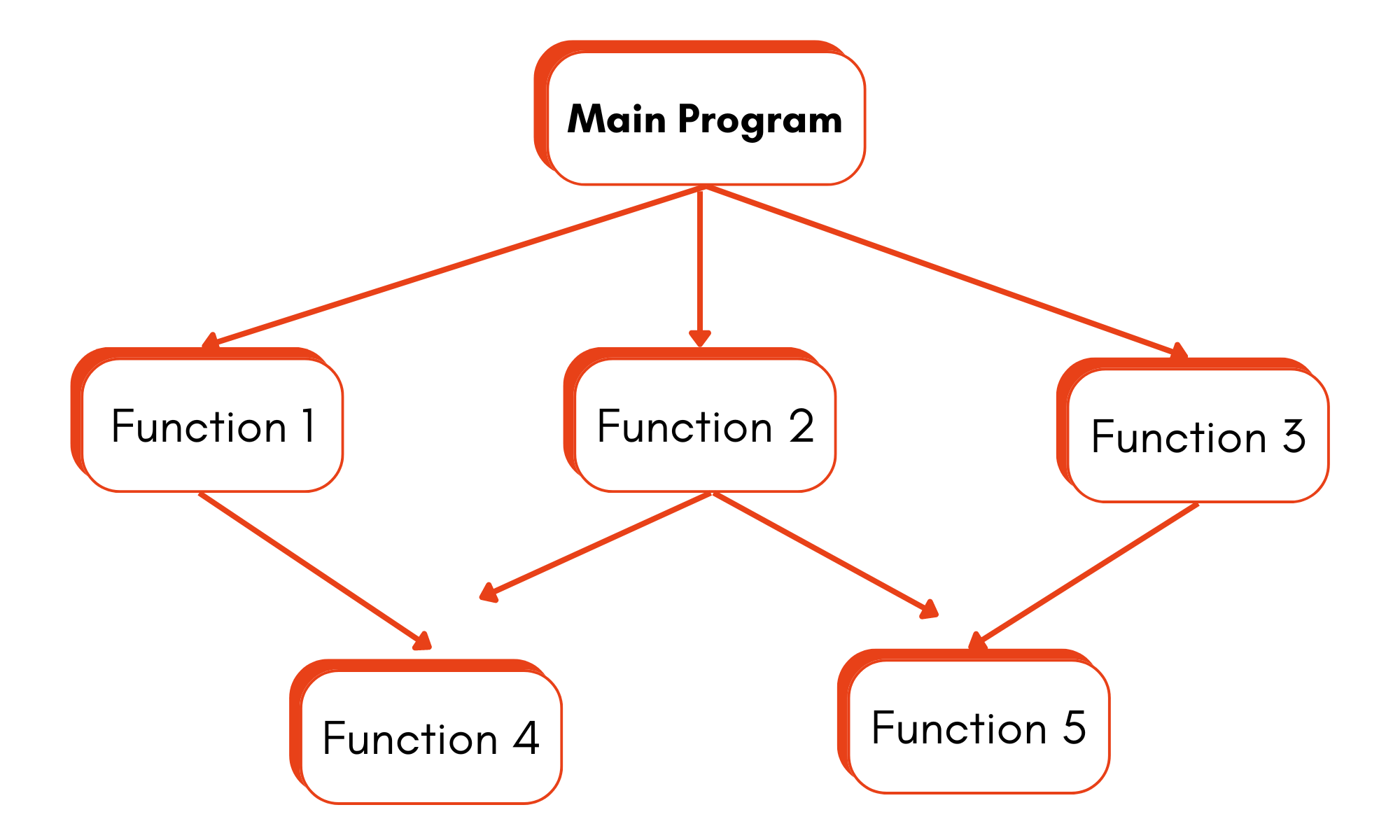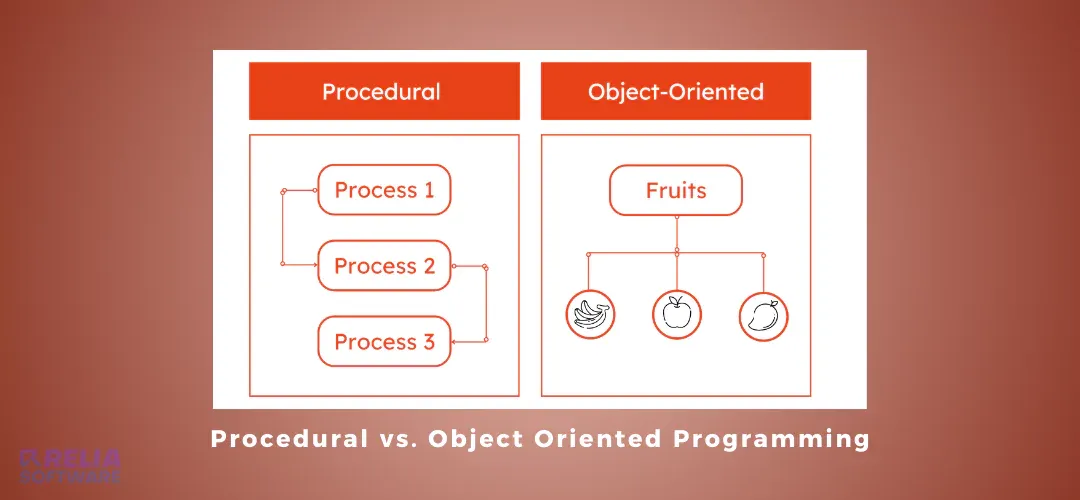If you are building a house, you may place every brick one at a time with a thorough design. Perfect for small tasks with clear steps, this is like procedural programming (POP). What happens, though, if you are building a skyscraper? Object-Oriented Programming (OOP) comes in; it lets you make reusable wall, door, and window blueprints (classes), making complex projects efficient and organized. This guide dives into both POP and OOP, helping you decide which "toolbox" is best for the job at hand.
>> Read more:
- Strategies for Success in Mobile App Development
- Custom Web App Development: Detailed Explanation
Understanding Procedural Programming (POP)
Procedural Programming (POP) is a structured programming approach where the program logic is decomposed into a sequence of self-contained procedures or functions. Each procedure has a clear purpose and can be invoked independently, promoting modularity and code organization.
POP likes building with LEGOs. Each LEGO brick represents a simple instruction. By snapping them together in a specific order, you create a functioning program. In POP, this means breaking down tasks into clear, step-by-step instructions that the computer executes sequentially.

Understanding Object-Oriented Programming (OOP)
In contrast to POP, OOP offers a data-centric approach. It revolves around creating objects that represent real-world entities with their properties and functionalities. OOP emphasizes concepts like inheritance, polymorphism, and encapsulation to create reusable, maintainable, and modular programs, particularly suited for complex projects.
Explore the in-depth explanation of Object-Oriented Programming concepts and principles in our dedicated article.
Key Differences Between Procedural and Object-Oriented Programming
Procedural Programming (POP) and Object-Oriented Programming (OOP) represent two fundamental approaches to structuring software. While both aim to achieve program functionality, they differ significantly in their core concepts, program organization, and suitability for various project types. Here's a detailed comparison across key aspects:
Focus
POP: Focuses on procedures (functions) that define a sequence of steps to complete a task. Data is often passed around as arguments to these procedures.
OOP: Centers around objects, which encapsulate data (attributes) and the actions (methods) that operate on that data.
Program Structure
POP: Programs are organized as a collection of functions, often with a main function that calls other functions in a specific order. Data can be global (accessible from anywhere in the program) or passed as arguments between functions, potentially leading to scattered logic.
OOP: Programs are structured around objects that interact with each other. Objects are created from blueprints called classes, which define the attributes and methods common to all objects of that class. This promotes modularity and clear separation of concerns.
Data Organization
POP: Data can be stored in global variables, local variables within functions, or passed as arguments. This can lead to data redundancy and difficulty in tracking data ownership, especially in large projects.
OOP: Data is encapsulated within objects, promoting data integrity and security. Objects control access to their data through methods, ensuring data manipulation happens in a controlled manner.
Code Reusability
POP: Reusability is limited. Functions can be reused, but complex functionalities might require code duplication across different parts of the program, making maintenance difficult.
OOP: OOP emphasizes code reusability through inheritance and polymorphism. Inheritance allows creating new classes (subclasses) that inherit properties and methods from existing classes (superclasses), promoting code reuse and extensibility. Polymorphism allows objects of different classes to respond to the same method call in different ways, making code more flexible and adaptable.
Maintainability
POP: Maintaining large POP programs can become challenging due to scattered logic across functions and potential reliance on global variables. Changes in one function might have unintended consequences elsewhere.
OOP: OOP promotes better maintainability by encapsulating data and functionality within objects. Changes are localized and less likely to cause unintended side effects. Additionally, inheritance allows modifying behavior in subclasses without altering the parent class, making updates easier.
Here's a table summarizing the key differences:
| Feature | Procedural Programming (POP) | Object-Oriented Programming (OOP) |
| Focus | Procedures (functions) | Objects (data + behavior) |
| Program Structure | Sequence of functions | Objects interacting with each other |
| Data Organization | Global/local variables, function arguments | Encapsulated within objects |
| Code Reusability | Limited, prone to duplication | High through inheritance and polymorphism |
| Maintainability | Challenging for large projects | Improved due to encapsulation and inheritance |
| Suitability | Simple tasks, smaller projects, education | Complex projects, code reusability, real-world modeling |
| Example Languages | C, FORTRAN, Pascal | C++, Java, Python, C# |

POP vs. OOP: Which to Choose?
Understanding the strengths and weaknesses of both Procedural Programming (POP) and Object-Oriented Programming (OOP) is crucial for selecting the most suitable approach for your programming projects. Here's a guide to help you make an informed decision:
Choosing POP
Consider POP for:
- Simple, well-defined tasks: If your program involves a linear sequence of instructions with minimal data manipulation, POP's straightforward approach can be efficient. (e.g., calculating statistics, basic data processing)
- Smaller projects: For smaller programs where maintainability concerns are less critical, POP's simplicity can be advantageous, allowing for quicker development.
- Educational purposes: POP's clear structure makes it a valuable tool for beginners to learn programming fundamentals.
Choosing OOP
Consider OOP for:
- Complex projects: When dealing with intricate data structures, complex functionalities, and real-world entity modeling (e.g., user interfaces, game development), OOP's object-centric approach promotes better organization, maintainability, and reusability.
- Code reusability: If your project requires extensive code reuse, OOP's inheritance and polymorphism features allow you to create reusable components and adapt them efficiently.
- Large-scale development: For projects with long-term development plans and a need for maintainability as the codebase grows, OOP's modular structure makes it easier to manage and update.
Hybrid Approaches
In some cases, you might consider a hybrid approach that combines elements of both POP and OOP. Here's when it might be beneficial:
- Large projects with well-defined subtasks: If your project has a complex overall structure but includes well-defined subtasks, you can leverage OOP for the main structure and utilize POP for simpler subtasks within the objects.
- Phased development: When starting a project with a less clear scope, you might begin with a simpler POP approach for initial development and then gradually migrate towards OOP as requirements solidify and the project grows in complexity.
>> Read more:
Conclusion
So, which toolbox to choose: POP or OOP? The answer isn't a one-size-fits-all. For small jobs like hammering nails, a basic hammer (POP) might suffice. But for building a skyscraper, a set of well-organized, reusable blueprints and components (OOP) becomes essential. Ultimately, understanding both paradigms empowers you to select the most effective approach for the task at hand.
>>> Follow and Contact Relia Software for more information!
- development
- Web application Development
- Mobile App Development

